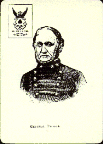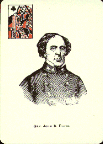The box of the deck (which simply shows the portrait of Robert E. Lee,
the three of hearts, on the front) has this description of the deck on
the back:
Confederate Generals
The Confederate Generals of the Civil War deck is a facsimile reproduction
of playing cards originally published in 1863 by M. Nelson, New York. Each
card features an engraved portrait of a general or statesman of the Confederacy.
Jokers were not included in the original deck, but this reproduction includes
two extra cards that bear a list of the names and the dates of birth and
death of each figure appearing in the deck. The spellings of the names
or the names themselves may differ from those on the cards, due to errors
in the original deck.
The Civil War started on April 12, 1861, when Confederate artillery
shelled Fort Sumter in the harbor of Charlestown, S.C. Many persons called
this tragic conflict the War Between the States, the War of Secession,
or the War for Southern Independence.
Northern troops called the gray-uniformed Southern soldier Johnny
Reb for "rebel." The Civil War produced numerous colorful personalities,
many of whom are featured in the Confederate Generals of the Civil War
Playing Card deck. General Robert E. Lee stood off superior numbers for
four years and came to symbolize gallantry and devotion to the Southern
cause.
The Confederate Army also had such military leaders as "Stonewall" Jackson,
the infantry genius, and Pierre Beauregard, the general who commanded the
Confederate forces that attacked Fort Sumter.
The surrender of the Confederate States in the spring of 1865 ended
a southern way of life that depended on slave labor in cotton and tobacco
fields. The war resulted in a stronger Union of the States.
All images © U.S. Games Systems, displayed here for commentary, analysis
and appreciation only.
![[Card Backs]](gensbk2.gif) This
is half of a pair of decks, together showing one hundred and four portraits
of generals who fought on both sides of the American Civil War. Originally
published by one M. Nelson of New York, these decks have been reissued
in facsimile by U.S.
Games Systems. The deck shown here shows the generals of the Confederacy
(the Southern states), and the other deck shows Union (Northern) Generals.
It is a simple deck, showing just the engraved portraits and the name of
the general. In the upper left-hand corner is a small, unassuming image
of a playing card from the period which identifies the suit and rank of
the particular card.
This
is half of a pair of decks, together showing one hundred and four portraits
of generals who fought on both sides of the American Civil War. Originally
published by one M. Nelson of New York, these decks have been reissued
in facsimile by U.S.
Games Systems. The deck shown here shows the generals of the Confederacy
(the Southern states), and the other deck shows Union (Northern) Generals.
It is a simple deck, showing just the engraved portraits and the name of
the general. In the upper left-hand corner is a small, unassuming image
of a playing card from the period which identifies the suit and rank of
the particular card.



